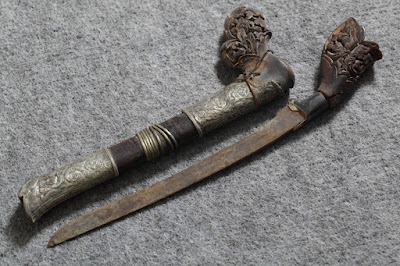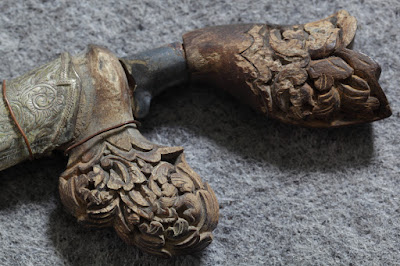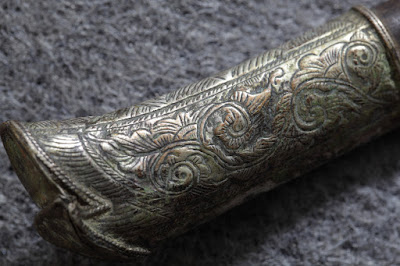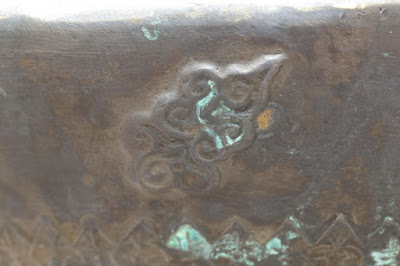The badik or badek is a knife or dagger developed by the Bugis and Makassar people of Southern Sulawesi, Indonesia. It consists of three parts, namely the handle and blade, as well as the sheath or scabbard. It comes in a great variety of shapes and sizes. The badik can have a straight, curved, bulbous or wavy, single or double-edged blade. The blade is smooth or with hollow sections (fullered). The point of the blade can be either pointed or rounded. Like the keris, the shape of the blade is asymmetric and often shows patterns typical of pamor (pattern welding steel commonly known as Damascus steel). However, it differs from the keris in that the badik does not have a ganja (a buffer strip steel).
Some versions from Sulawesi are decorated with inlaid gold figure on the blade called jeko. The handle is made of wood, horn or ivory in a shape of a pistol grip at a 45° to 90° angle or similar in a bent shape often decorated with carvings.
From its native Sulawesi, the badik soon spread to neighbouring islands like Java, Borneo, Sumatra and as far as the Malay Peninsula, creating a wide variety of badik according to each region and ethnic group. There are many versions made and used throughout the Indonesian archipelago alone.
As with other blades in the Malay Archipelago, traditionally-made badik are believed to be imbued with a supernatural force during the time of their forging. Aside from being used as a weapon and hunting tool, the badik is a symbol of cultural identity in Sulawesi. The Bugis and Makassar people still carry badik as part of their daily attire today. The badik is worn on the right side, butt end of the handle pointing to the rear. It may also be positioned at their left side providing the butt end of the handle points to the rear. When the weapon is shifted from the right to the left side, or when worn at the left, handle reversed facing forward, it is signatory of impending combat.
Pictures below showing a badik from my collection. This badik has a chape, upper scabbard and hilt ring all encased in sheet silver that is engraved with scrolling plant motifs.
The wooden scabbard is further decorated with eight bands of silver. The hand guard and hilt are of finely carved and pierced wood.
Length : 25cm
Some versions from Sulawesi are decorated with inlaid gold figure on the blade called jeko. The handle is made of wood, horn or ivory in a shape of a pistol grip at a 45° to 90° angle or similar in a bent shape often decorated with carvings.
From its native Sulawesi, the badik soon spread to neighbouring islands like Java, Borneo, Sumatra and as far as the Malay Peninsula, creating a wide variety of badik according to each region and ethnic group. There are many versions made and used throughout the Indonesian archipelago alone.
As with other blades in the Malay Archipelago, traditionally-made badik are believed to be imbued with a supernatural force during the time of their forging. Aside from being used as a weapon and hunting tool, the badik is a symbol of cultural identity in Sulawesi. The Bugis and Makassar people still carry badik as part of their daily attire today. The badik is worn on the right side, butt end of the handle pointing to the rear. It may also be positioned at their left side providing the butt end of the handle points to the rear. When the weapon is shifted from the right to the left side, or when worn at the left, handle reversed facing forward, it is signatory of impending combat.
Pictures below showing a badik from my collection. This badik has a chape, upper scabbard and hilt ring all encased in sheet silver that is engraved with scrolling plant motifs.
The wooden scabbard is further decorated with eight bands of silver. The hand guard and hilt are of finely carved and pierced wood.
Length : 25cm

























